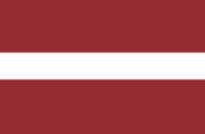- The official name of the country is Latvijas Republika, translated as the Republic of Latvia.
- Government. Latvia is a democratic parliamentary republic established in 1918.
- History. Around 3000 BCE the proto-Baltic ancestors of the Latvian people settled on the eastern coast of the Baltic Sea. The Balts established trade routes to Rome and Byzantium. By 900 ACE, 5 tribes inhabited Latvia: Curonians, Latgalians, Selonians, Semigallians, and the Livonians. Starting in the 13th century Latvia was at various times split up and ruled by the Germans, Poland, Lithuania, Sweden, and Russia. Independence was restored in 1991.
- Geography. Latvia lies on the eastern shores of the Baltic Sea on the level northwestern part of the rising East European platform, between Estonia and Lithuania. Latvia has over 12,000 rivers, only 17 of which are longer than 60 miles long, and over 3,000 small lakes.
- Climate. The damp climate of Latvia resembles New England's. Latvia has an European continental influenced climate with warm, dry summers and severe winters.
- Natural Resources. Other than peat, dolomite, and limestone, gypsum, and clay, natural resources are scarce. Fish from the Baltic Sea is another potential export resource export. Amber, million-year-old chunks of petrified pine pitch, is often found on the beaches of the Baltic Sea and is in high demand for jewelry.
- Riga. The capital of Latvia, Riga, is called the "European Capital of Culture". It has many museums.
- Olympics. In 1952, Latvian athletes who qualified for Olympic competition could only do so as part of the USSR. The Latvian Olympic Committee never withdrew its membership from the IOC. The majority of the Latvian Olympic Committee fled to the West but many famous Latvian sportsmen died in the Siberian camps.
- Latvia has 500 kilometres of beach along the Baltic Sea. It has modern port cities, resort cities, old fishing villages, and natural areas.
- Economy. After a harsh recession, Latvia now has the fastest growing economy in the European Union.
- Cuisine. Latvian traditional cuisine consists of meat, fish, potatoes, wheat, barley, cabbage, onions, eggs and pork. Latvian food is generally quite fatty, and uses few spices. Grey peas and ham, sorrel soup and Rye Bread (Rupjmaize) are traditional foods.
- Castles. There are many medieval castles in Latvia. Dundaga, for example, was named for the sounds of a bell heard by a boy in the belfry of the castle: "Dung, dung - dang, dang". When the boy mentioned this name, he was said to have turned into stone. This stone is supposedly still in the castle.
FRUA is a service-marked acronym of Families for Russian and Ukrainian Adoption in use since 1994. It and the full organizational name,
Families for Russian and Ukrainian Adoption, are not to be used to describe any organization or service not related to FRUA, without permission.
Families for Russian and Ukrainian Adoption, are not to be used to describe any organization or service not related to FRUA, without permission.
© 2023 Families for Russian and Ukrainian Adoption Including Neighboring Countries






